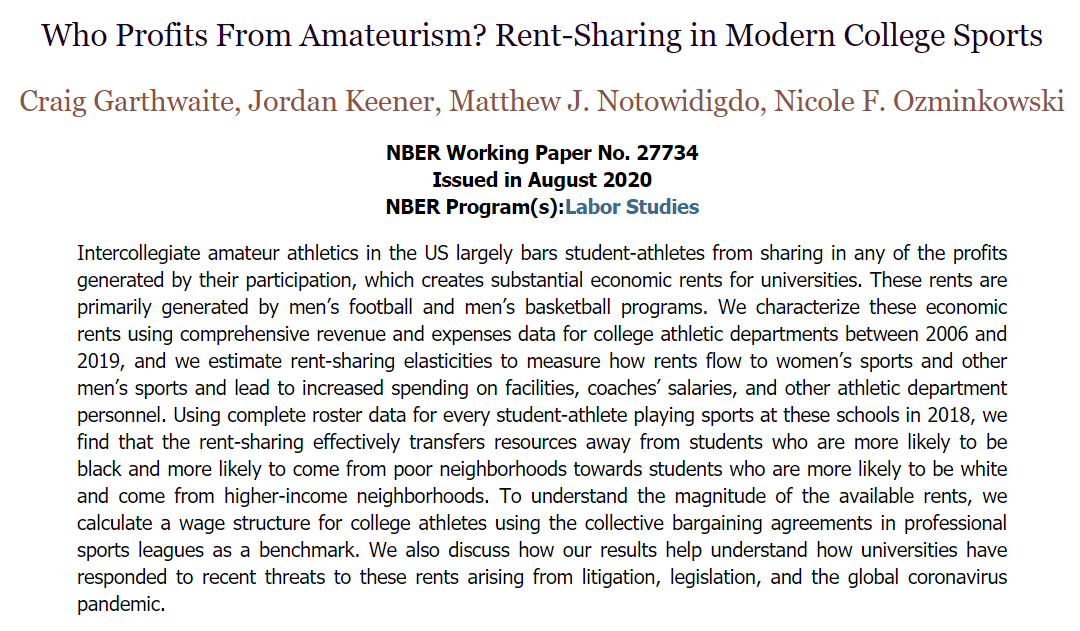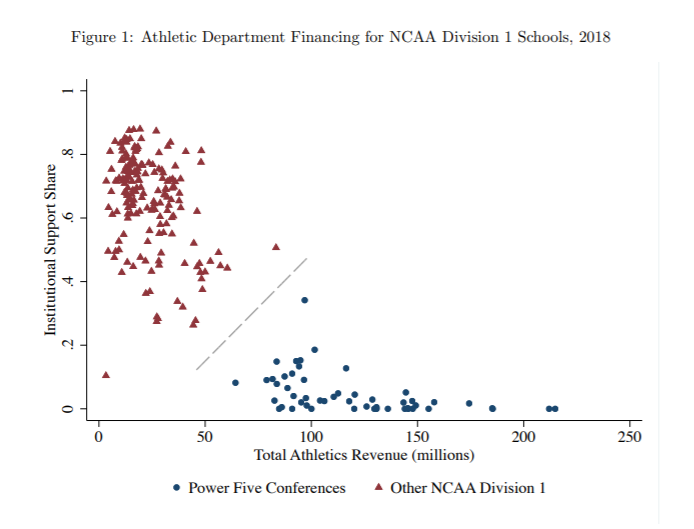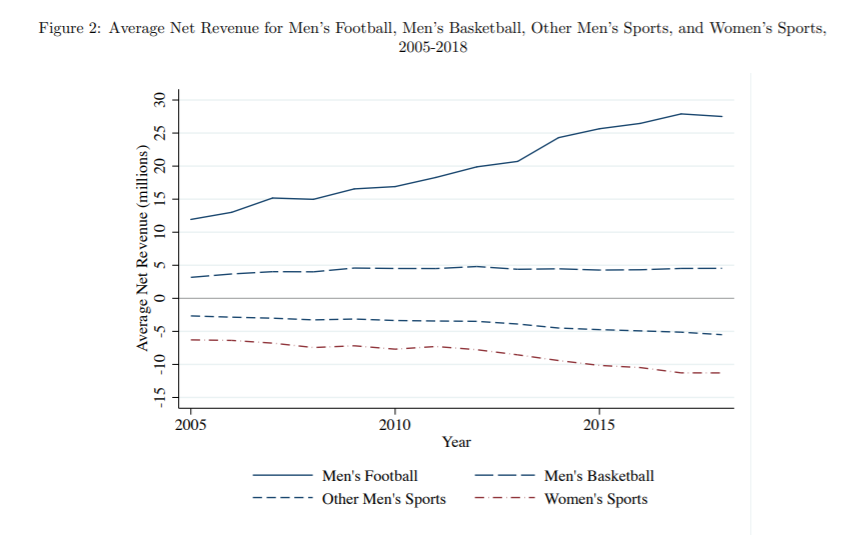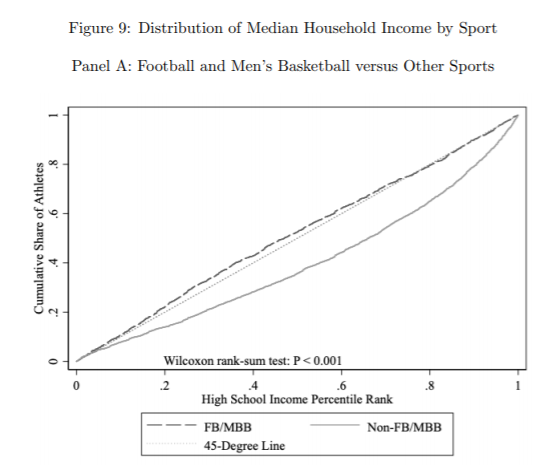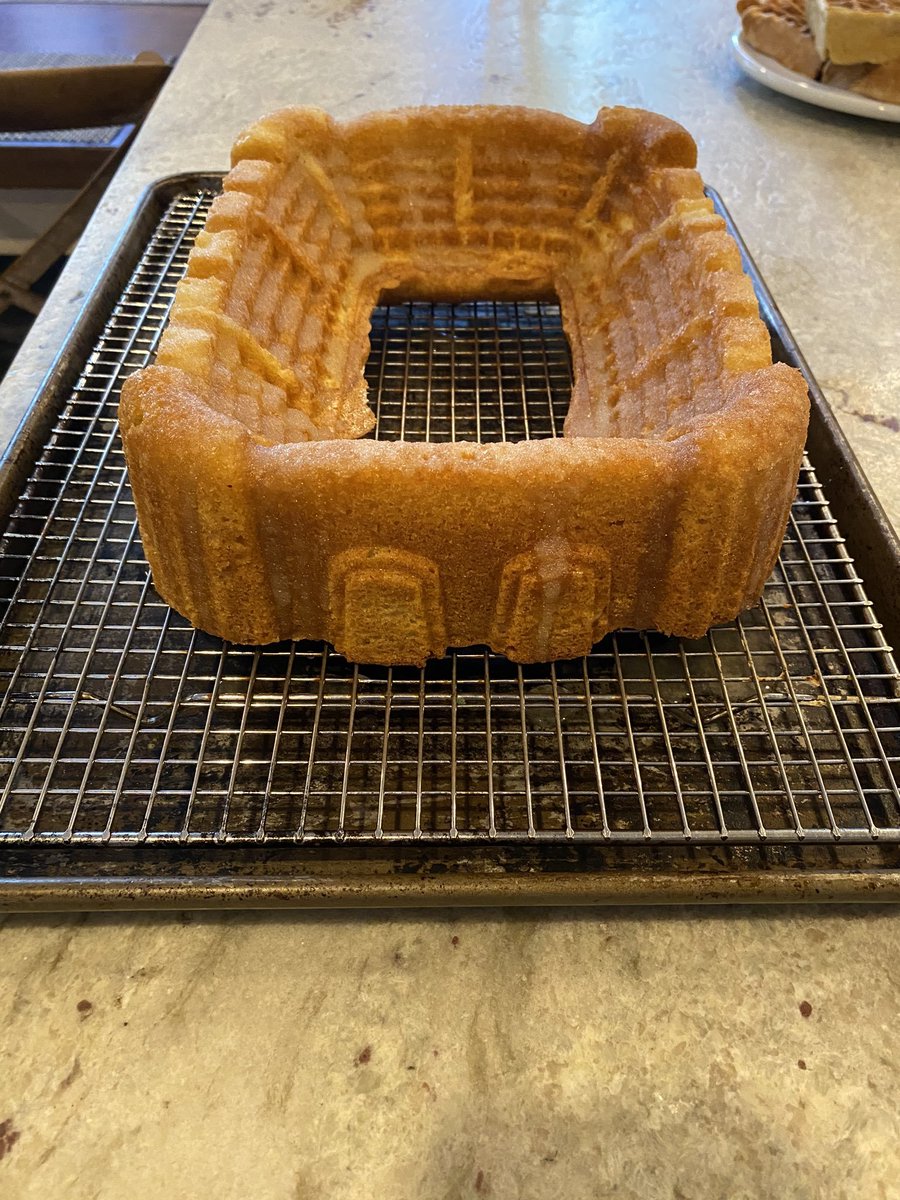Modern college athletics rests on a set of regressive transfers.
The pandemic is revealing this corrupt bargain by forcing shools to cancel money losing sports, slow new building, and reduce salaries.
We demonstrate these dynamics in a new paper (1/6)
https://www.nber.org/papers/w27734.pdf">https://www.nber.org/papers/w2...
The pandemic is revealing this corrupt bargain by forcing shools to cancel money losing sports, slow new building, and reduce salaries.
We demonstrate these dynamics in a new paper (1/6)
https://www.nber.org/papers/w27734.pdf">https://www.nber.org/papers/w2...
The first important fact: there are two business models in Division 1 college sports: "The Power 5" conferences and everyone else.
Power 5 athletic departments earn high revenues and take little direct support from main school.
It& #39;s a business, let& #39;s analyze it like one (2/6)
Power 5 athletic departments earn high revenues and take little direct support from main school.
It& #39;s a business, let& #39;s analyze it like one (2/6)
Business has been good! Particularly for the "revenue sports," i.e. football and men& #39;s basketball.
Profits for football have grown markedly.
This chart even downplays profits because a lot of media rights aren& #39;t counted as "revenue sport" revenue -- even though they are (3/6)
Profits for football have grown markedly.
This chart even downplays profits because a lot of media rights aren& #39;t counted as "revenue sport" revenue -- even though they are (3/6)
In the past decade money FLOODED into college sports from TV rights. This is all driven by football and men& #39;s basketball.
We follow economics rent sharing literature to examine where the money goes? (spoiler alert: it& #39;s not to the athletes responsible for generating it) (4/6)
We follow economics rent sharing literature to examine where the money goes? (spoiler alert: it& #39;s not to the athletes responsible for generating it) (4/6)
Using a variety of identification strategies, we identify three consistent areas sharing increased rents:
(1) Other money-losing sports;
(2) Coaching and administrative salaries; and
(3) Facility spending.
Revenue sport athletes don& #39;t enjoy more money because they can& #39;t (5/6)
(1) Other money-losing sports;
(2) Coaching and administrative salaries; and
(3) Facility spending.
Revenue sport athletes don& #39;t enjoy more money because they can& #39;t (5/6)
We use roster data to link athletes to their high school using.
Revenue sport athletes come from high schools where families earn meanignfully less money and there are a greater share of black students. Other data show revenue sport athletes are far more likely to be black (6/6)
Revenue sport athletes come from high schools where families earn meanignfully less money and there are a greater share of black students. Other data show revenue sport athletes are far more likely to be black (6/6)
This means at its heart, college sports& #39; system of "amateurism" transfers money from athletes who are more likely to be from poor families and black and gives it to sports where athletes are more likely to be white and from wealthier families.
But it doesn& #39;t stop there ... (7/6)
But it doesn& #39;t stop there ... (7/6)
While "amateur" athletes can& #39;t earn salaries -- their coaches can. And these salaries have grown. From 2008 to 2018, the average tab for Power 5 football staffs grew from $4.8 to $9.8 million. Salaries are even higher at "top" schools where they approach $20 million (8/6)
As a side note from the paper, the coaches are pretty egregious in their discussion of these salaries.
Perhaps the worst is Dabo Swinney who is a horrible hypocrite profiting off of amateurism (you can see my thoughts below on this) (9/6) https://twitter.com/C_Garthwaite/status/1121800646649241600">https://twitter.com/C_Garthwa...
Perhaps the worst is Dabo Swinney who is a horrible hypocrite profiting off of amateurism (you can see my thoughts below on this) (9/6) https://twitter.com/C_Garthwaite/status/1121800646649241600">https://twitter.com/C_Garthwa...
The final category is facility spending, where schools spends tens of millions of dollars on buildings with absurd amenities such as lazy rivers and lazer tag.
They are doing this to attract better athletes that they otherwise would pay -- except the NCAA won& #39;t allow that (10/6)
They are doing this to attract better athletes that they otherwise would pay -- except the NCAA won& #39;t allow that (10/6)
Putting it all together -- wer follow the money in college sports. Economic rents generated by revenue sports athletes are "shared" in a fundamentally regressive manner.
When you lament the loss of some sports following the pandemic, you& #39;re supporting these transfers (11/6)
When you lament the loss of some sports following the pandemic, you& #39;re supporting these transfers (11/6)
We can argue how much athletes can be paid, but our paper (and many others) have shown the money is clearly there. Under some scenarios we show a starting QB could earn more than $2 million a year and the lowest paid player would still earn more than the cost of attendance (12/6)
But you& #39;d have to give up things.
This would run right into a question about Title IX and funding women& #39;s sports.
While we agree there are many important benefits to funding women sports, any conversation about equity MUST include where that money is coming from (13/6)
This would run right into a question about Title IX and funding women& #39;s sports.
While we agree there are many important benefits to funding women sports, any conversation about equity MUST include where that money is coming from (13/6)
When ever increasing sums are generated by efforts of athletes that are more likely to be from poor families and black -- is it clearly equitable to transfer that money to fund women& #39;s sports populated by athletes from families that are richer and more likely to be white (14/6)
I don& #39;t have an answer to that question -- but it is clearly the question that we should ask and we hope that this broad view of the economics of college sports in one paper (combined with the new facts on regressivity and rent sharing) can help with that conversation (15/6)
One final point, and this is from a fan that baked a cake yesterday to memorialize the loss of Michigan Football.
Even I was shocked by how fast the money grew in the past decade.
We are all frogs in boiling water that haven& #39;t noticed how exactly much money there is now (16/6)
Even I was shocked by how fast the money grew in the past decade.
We are all frogs in boiling water that haven& #39;t noticed how exactly much money there is now (16/6)
The pandemic provides a unique opportunity to take a step back and reconsider.
College sports are a HUGE business.
Everyone is a pig stepping up to the trough except the key input -- who isn& #39;t allowed to profit from their efforts and health risks.
That can& #39;t be fair (17/17)
College sports are a HUGE business.
Everyone is a pig stepping up to the trough except the key input -- who isn& #39;t allowed to profit from their efforts and health risks.
That can& #39;t be fair (17/17)
And for those of you stumbled across this and don& #39;t follow my normal health care economics content -- apologies for the numbering system and the false advertising on thread length.
The best laid plans of mice and men, etc.
I get excited and go on.
The best laid plans of mice and men, etc.
I get excited and go on.

 Read on Twitter
Read on Twitter